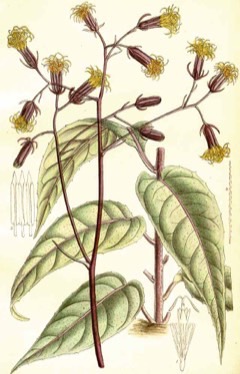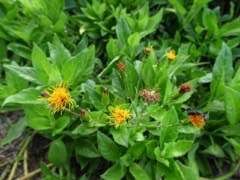 |
|
edibleplants.org |
 |
| Forest Starr and Kim Starr flickr.com/people/97499887@N06 |
Translate this page:
Summary
Gynura procumbens, also known as Longevity Spinach or Sambung Nyawa, is a perennial climbing plant native to Southeast Asia. The leaves of the plant are used in traditional medicine. The leaves are green and fleshy and taste like green beans. Young leaves and shoots are eaten fresh in salads or added to rice or noodle dishes. Cook like spinach, sauté in butter or oil and a little garlic or add to soups or stews. They are used as a vegetable or as a flavouring for food. The specific epithet procumbens means lying flat on the ground or creeping forward.
Harvesting: Leaves throughout the growing season from spring to early autumn.
Physical Characteristics

 Gynura procumbens is an evergreen Perennial Climber growing to 2 m (6ft) by 0.3 m (1ft in) at a fast rate.
Gynura procumbens is an evergreen Perennial Climber growing to 2 m (6ft) by 0.3 m (1ft in) at a fast rate.
See above for USDA hardiness. It is hardy to UK zone 10. The flowers are pollinated by Insects. The plant is self-fertile.
It is noted for attracting wildlife.
Suitable for: light (sandy), medium (loamy) and heavy (clay) soils, prefers well-drained soil and can grow in nutritionally poor soil. Suitable pH: mildly acid, neutral and basic (mildly alkaline) soils. It can grow in semi-shade (light woodland) or no shade. It prefers moist soil.
UK Hardiness Map
US Hardiness Map
Synonyms
Cacalia cylindriflora Wall. [Invalid]. Cacalia finlaysoniana Wall. [Invalid]. Cacalia procumbens Lour. Cacalia reclinata Roxb. Cacalia sarmentosa Blume. Cacalia sarmentosa Lesch. ex Blume. Crassocephalum baoulense (Hutch. & Dalziel) Milne-Redh. Crassocephalum latifolium S.Moore. G. buntigii S.Moore. G. affinis Turcz. G. agusanensis Elmer. G. baoulensis Hutch. & Dalziel. G. cavalerei H.L?v. G. clementis Merr. G. finlaysoniana DC. G. latifolia (S.Moore) Elmer. G. lobbiana Turcz. G. piperi Merr. G. pubigera Bold. G. sarmentosa (Blume) DC. G. scabra Turcz. Senecio baoulensis A.Chev. Senecio mindoroensis Elmer.
Plant Habitats
Edible Uses
Edible Parts: Leaves Shoots
Edible Uses: Condiment
Edible Uses Leaves - cooked [332 ]. The leaves are green and fleshy and said to taste like green beans. Young leaves and shoots are eaten fresh in salads or added to rice or noodle dishes. Cook like spinach, sauté in butter or oil and a little garlic or add to soups or stews. They are used as a vegetable or as a flavouring for food [301, 332 ].
References More on Edible Uses
Medicinal Uses
Plants For A Future can not take any responsibility for any adverse effects from the use of plants. Always seek advice from a professional before using a plant medicinally.
Antidiarrhoeal Antirheumatic Dysentery Febrifuge Hypoglycaemic Hypotensive Kidney
The plant is febrifuge [332 ]. It is used in the treatment of fevers, kidney troubles and dysentery [332 ]. The semi-succulent leaves are applied externally to relieve rheumatic pains and general body pains [332 ]. As a folk medicine in Singapore, the leaves are used to lower blood pressure and reduce blood sugar levels.
References More on Medicinal Uses
The Bookshop: Edible Plant Books
Our Latest books on Perennial Plants For Food Forests and Permaculture Gardens in paperback or digital formats.

Edible Tropical Plants
Food Forest Plants for Hotter Conditions: 250+ Plants For Tropical Food Forests & Permaculture Gardens.
More

Edible Temperate Plants
Plants for Your Food Forest: 500 Plants for Temperate Food Forests & Permaculture Gardens.
More

More Books
PFAF have eight books available in paperback and digital formats. Browse the shop for more information.
Shop Now
Other Uses
Agroforestry Uses: This plant can be used as a ground cover and is beneficial for soil health. It also attracts pollinators and can be integrated into a permaculture garden. The plant is grown in the rice area of Mindanao in the Philippine Islands as a 'remedy for rice aphids', but the manner of its action is not clear [332 ]. Other Uses: A useful forage plant for poultry. Pots; Suitable in 3 gallons (12L) or larger. 1. Nectary - Flowers rich in nectar and pollen:
Yes – Gynura procumbens produces flowers that can attract pollinators, providing nectar and pollen.
2. Wildlife - Food (Fruit, Seeds, Leaf litter, Shelter, Nesting, Roosting):
Yes – The leaves are edible and consumed by various insects and herbivores. The plant itself can offer some cover, but it is not specifically noted for nesting or roosting.
3. Invertebrate Shelter (Overwintering sites, Leaf litter, Groundcover):
Yes – The dense foliage can provide some shelter for invertebrates, and the leaf litter can support beneficial insects, although it may not be a primary overwintering site.
4. Pest Confuser (Smell):
Yes – The aromatic properties of the leaves may help confuse pests and attract beneficial insects, though specific studies on its effectiveness in this regard are limited.
Special Uses
Food Forest
References More on Other Uses
Cultivation details
Gynura procumbens is a small tropical perennial herb or climber grown indoors in colder climates. It is a close relative of Okinawa Spinach (Gynura crepioides). They are growing to 1 - 3 m in height with a scandent (climbing) growth habit. The specific epithet procumbens means lying flat on the ground or creeping forwards, in reference to the growth habit. The branches are trimmed to make a bushy plant or staked. Position: Sun / part shade. Soil preference: Well-drained. Leaves can be harvested throughout the growing season, generally from spring to early autumn.
Gynura procumbens typically flowers in late summer to autumn.
Longevity spinach is a fast-growing perennial, with the ability to reach maturity within a few months under optimal conditions.
References Carbon Farming Information and Carbon Sequestration Information
Temperature Converter
Type a value in the Celsius field to convert the value to Fahrenheit:
Fahrenheit:
The PFAF Bookshop
Plants For A Future have a number of books available in paperback and digital form. Book titles include Edible Plants, Edible Perennials, Edible Trees,Edible Shrubs, Woodland Gardening, and Temperate Food Forest Plants. Our new book is Food Forest Plants For Hotter Conditions (Tropical and Sub-Tropical).
Shop Now
Plant Propagation
Seed. Longevity spinach is very easy to grow and propagate from cuttings.
Other Names
If available other names are mentioned here
Longevity Spinach, Longevity Greens, Akar sebiak, Akar, Bau dat, Daun dewa, Ebure, Gipoi, Kacham akar, Kelemai merah, Kim that, Phti angkam, Rau hung lui, Sambung nyawa, Mollucan Spinach, Leaves of the Gods, Bai Bing Ca.
Native Range
TEMPERATE ASIA: Guangdong Sheng, Guizhou Sheng, Hainan Sheng, Yunnan Sheng,China. TROPICAL ASIA: India, Arunachal Pradesh, Papua New Guinea, Laos, Thailand, Indonesia, Malaysia, Philippines, Singapore, AFRICA: Ghana, Guinea, Liberia, Nigeria.
Weed Potential
Right plant wrong place. We are currently updating this section.
Please note that a plant may be invasive in one area but may not in your area so it's worth checking.
None Known
Conservation Status
IUCN Red List of Threatened Plants Status : Not Listed.

Growth: S = slow M = medium F = fast. Soil: L = light (sandy) M = medium H = heavy (clay). pH: A = acid N = neutral B = basic (alkaline). Shade: F = full shade S = semi-shade N = no shade. Moisture: D = dry M = Moist We = wet Wa = water.
Now available:
Food Forest Plants for Mediterranean Conditions
350+ Perennial Plants For Mediterranean and Drier Food Forests and Permaculture Gardens.
[Paperback and eBook]
This is the third in Plants For A Future's series of plant guides for food forests tailored to
specific climate zones. Following volumes on temperate and tropical ecosystems, this book focuses
on species suited to Mediterranean conditions—regions with hot, dry summers and cool, wet winters,
often facing the added challenge of climate change.
Read More
Expert comment
Author
(Lour.) Merr.
Botanical References
Links / References
For a list of references used on this page please go here
A special thanks to Ken Fern for some of the information used on this page.
Readers comment
| Add a comment |
|
If you have important information about this plant that may help other users please add a comment or link below. Only comments or links that are felt to be directly relevant to a plant will be included. If you think a comment/link or information contained on this page is inaccurate or misleading we would welcome your feedback at [email protected]. If you have questions about a plant please use the Forum on this website as we do not have the resources to answer questions ourselves.
* Please note: the comments by website users are not necessarily those held by PFAF and may give misleading or inaccurate information.
To leave a comment please Register or login here All comments need to be approved so will not appear immediately.
|
Subject : Gynura procumbens
|
|
|
|